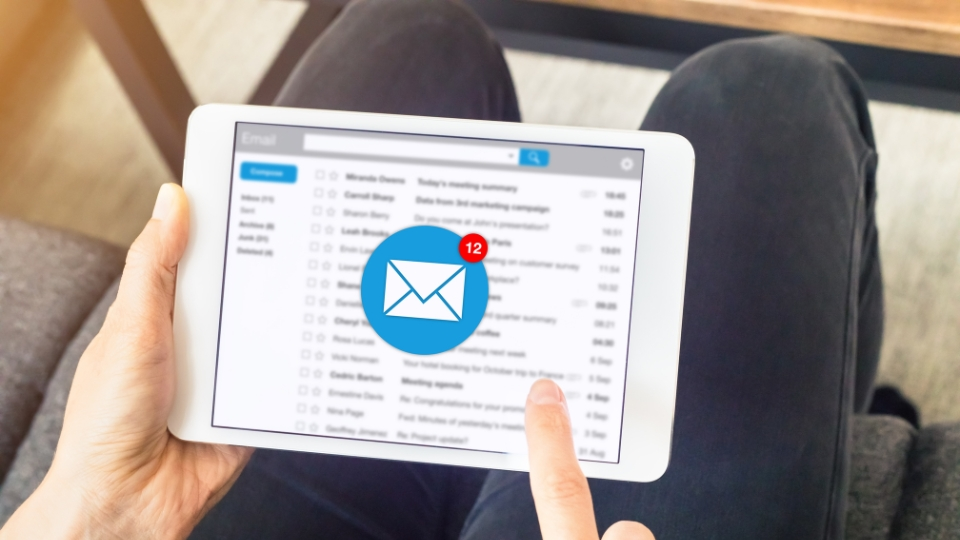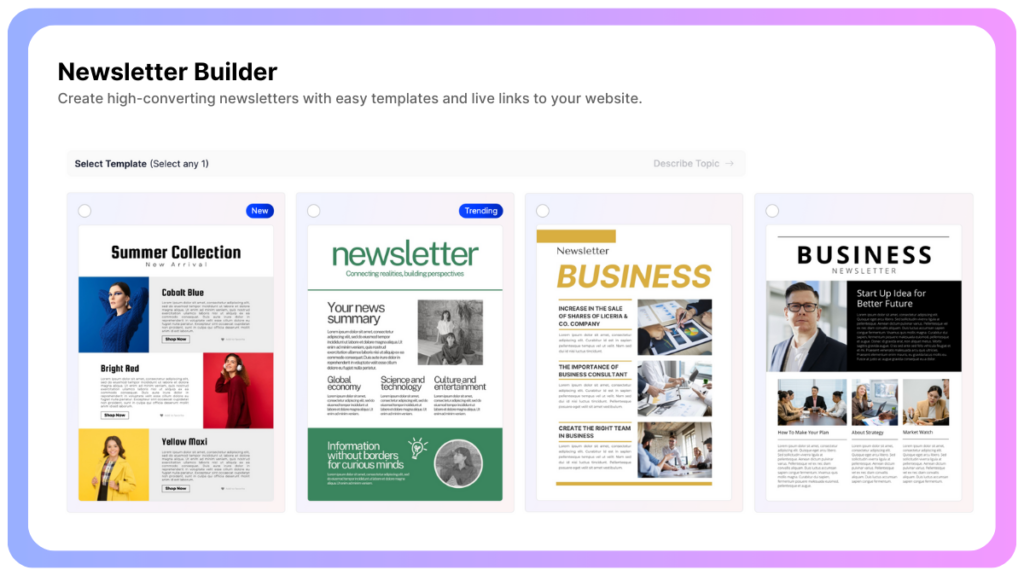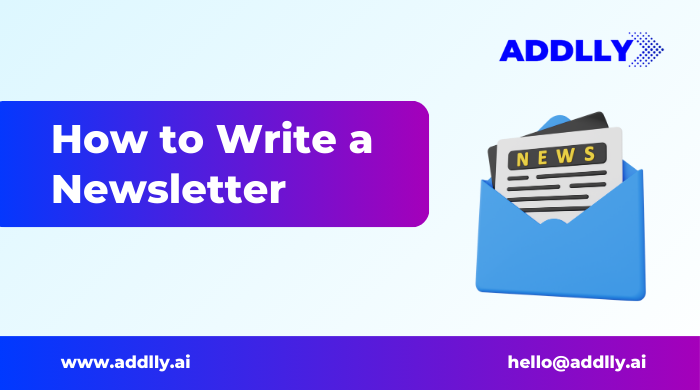In 2024, learning how to write a newsletter effectively is important for engaging your audience and driving conversions for your business. Whether you’re promoting a blog post, sharing important business updates, or just delivering user-generated content, newsletters remain a powerful tool.
The key to a successful newsletter lies in creating compelling content, choosing the right subject lines, and understanding your target audience.
This guide will provide you with essential tips to help you create a newsletter that not only reaches your target audience but also resonates with your readers, increasing engagement and ensuring your messages are seen on mobile devices and beyond.
You will also learn how you can use an AI newsletter generator to create newsletters easily with ready-made design templates.
Quick Summary Powered by Addlly AI
ToggleWhy Newsletters Are Essential in 2024?

With the rise of AI, newsletters have regained their importance as a direct line to consumers in 2024, offering a way to deliver interesting content straight to user’s mail account. Unlike social media, where posts can get lost in the noise, newsletters allow you to maintain a consistent schedule and keep your audience engaged.
With the rise of mobile users and AI, newsletters are now more accessible than ever, making it easier to reach readers wherever they are. For businesses, newsletters provide a platform to share free resources, promote relevant blog posts, and build a loyal subscriber base through regular, informative updates.
Tips on How To Write a Successful Newsletter

1. Understand Your Audience and Brand Voice
Understanding your target audience is crucial for creating a successful newsletter and developing a distinctive brand voice. Brand voice is how your company’s personality and values come through in your communication. Research your readers’ interests and challenges to tailor your content and shape a brand voice that resonates with them.
Your brand voice—whether formal or casual, humorous or serious—should align with your audience’s preferences. Consistently using this voice in your newsletters, regardless of the platform, will increase engagement and build a stronger connection with your readers. This approach leads to higher open rates, more interactions with your calls-to-action, and a growing subscriber base.
2. Choose an Eye Catchy Topic
The topic of your email newsletters is the first thing your audience will notice, so it’s important to make it compelling. An eye-catching topic can be the difference between your newsletters being opened or ignored.
Consider what is most relevant to your readers and how you can frame it in a way that grabs attention. Use keywords that resonates with your audience, and don’t be afraid to get creative. A well-chosen topic not only draws readers attention but also sets the tone for the entire newsletter, ensuring your audience stays engaged from start to finish.
3. Go for a Strong Subject Line
Your subject line is your first chance to grab your readers’ attention, once your mail lands in users inbox. A strong subject line should be clear, concise, and enticing, giving a glimpse of what the reader can expect inside.
Avoid overly generic or vague phrases; instead, use action words and relevant keywords that appeal to your target audience. Experiment with different styles, such as questions or even a touch of humour, to see what resonates the best.
Remember, the goal of email marketing is to make your email newsletters stand out in crowded inboxes and encourage readers to click and read the full article on your website.
4. Create Compelling Content
Creating good content is the heart of a newsletter. Your content should be informative, engaging, and aligned with the interests of your audience. Use a mix of short paragraphs, bullet points, and listicles to break up the text and make it easy to read.
Add high-quality images and visuals to enhance the content and keep it interesting. The more compelling your content, the more likely your readers are to engage and share.
5. Use Visible and Clear Call to Action Buttons
Call to action (CTA) buttons are important in guiding your readers toward the next step, whether it’s clicking to your website, reading a full article, signing up for a service, or buying a product. Ensure that your CTA buttons are clearly visible and labelled, making it easy for readers to know exactly what action to take.
Use contrasting colors to make the buttons stand out and place them strategically within the newsletter, such as after key sections or near the end. A well-designed CTA button can significantly increase the click-through rates, driving more traffic to your website or blog.
6. Include Textual Links
In addition to clear CTA buttons, including textual links throughout your newsletter can provide additional path for engagement. These links should be relevant to the content and offer value to the reader, such as leading to related blog posts, free resources, or important pages on your website.
Make sure to use your anchor texts that clearly describes what the reader will find when they click on the links.
7. Break Content in Listicles
Breaking your content into listicles is an effective way to make your newsletter more readable and engaging. Listicles, or list-based content, are easy to scan, allowing readers to quickly find the information that interests them most. This format is particularly useful for busy readers who may not have time to read a full newsletter content but still want to gather important details.
By organizing content in listicles, you can present complex information in a simplified manner, making your newsletter more appealing and increasing the likelihood that your readers will engage with the content.
8. Include High Quality Clean and Informative Images
Visuals play an important role in capturing your audience’s attention and enhancing the overall appeal of your newsletter. High-quality, clean, and informative images can break up the text, making your newsletter more visually appealing and easier to read. Choose images that are relevant to the content and add value to the message you’re conveying.
Whether it’s a photo, infographic, video, or illustration, make sure your images are clear and optimized for both desktop and mobile devices. Including the right visuals can significantly increase reader engagement and make your newsletter more memorable.
How To Make Your Newsletter Successful?
1. Design Your Newsletter for Maximum Impact
Design plays an important role in the success of your newsletter. A well-designed newsletter is not only visually appealing but also easy to navigate, ensuring your readers can quickly find the information they’re looking for.
Use a clean, uncluttered layout with plenty of white space to make the content stand out. Ensure that your design is mobile-friendly, as a significant portion of your audience will likely access the newsletter on mobile devices. Incorporating your brand’s colors and logos consistently helps reinforce brand identity while enhancing the overall reader experience.
2. Give Your Newsletters a Personal Touch
Adding a personal touch to your newsletters can make your audience feel more connected to your content. Use personalized greetings and tailor the content to specific segments of your subscriber list based on their interests or past behavior. Mentioning the reader’s name, referencing past interactions, or offering content that aligns with their preferences can significantly increase engagement.
Personalized newsletters show that you understand your audience’s needs and are dedicated to providing them with relevant, valuable content. This approach helps build trust and encourages readers to keep opening and engaging with your emails.
3. Use Automation Tools to Improve the Efficiency
Automation tools can enhance the efficiency and effectiveness of your newsletter campaigns. These tools allow you to schedule emails, segment your audience, and personalize the content with minimal effort. By automating routine tasks, you can focus more on creating quality content and engaging with your readers.
Popular email marketing platforms offer features like drip campaigns, which automatically sends a series of emails to subscribers over time, helping nurture leads and keep your audience engaged. Automation not only saves time but also ensures that your newsletters are delivered at optimal times, improving open rates and overall success.
4. Optimize the Delivery and Open Rates
Optimizing your newsletter’s delivery and open rates is essential for its success. Start by testing different send times to determine when your audience is most likely to open your emails. Avoid sending emails on Mondays or during holidays when people are less likely to check their inboxes. Use A/B testing to experiment with different subject lines and preview texts to see which combinations gives the highest open rates.
Additionally, ensure that your email list is up-to-date and free of inactive subscribers, as this can improve your sender reputation and increase the likelihood of your emails landing in the primary inbox.
5. Measure The Performance of Your Newsletter
Measuring the performance of your newsletters is important to understand what works and what doesn’t. Track key metrics such as open rates, click-through rates, and conversion rates to see your newsletter’s effectiveness. Use these insights to refine your newsletter strategy and make data-driven decisions.
Newsletter analytics can help you track how readers interact with your content once they click the link to your website. Regularly reviewing your newsletter’s performance allows you to identify trends, improve content, and ultimately, increase engagement and ROI for your email marketing efforts.
Mistakes to Avoid in Your Newsletter
1. Avoid Adding More Than 2 Call to Action Buttons
While CTAs are important for driving engagement, overloading your newsletter with too many can be counterproductive. Limiting your newsletter to one or two clear and distinct CTAs ensures that your readers aren’t overwhelmed with choices. When a newsletter includes multiple CTAs, it can dilute the impact of each CTA and reduce the overall effectiveness of your campaign.
Instead, focus on guiding your readers toward a specific CTA, whether it’s visiting your website, reading a blog post, or subscribing to a service. This focused approach will lead to higher click-through rates and better results.
2. Be Consistent in Sending Newsletter To Your Audience
Consistency is key to maintaining reader interest and engagement. A consistent schedule not only helps build trust with your audience but also keeps your relationship strong. Whether you choose to send weekly, bi-weekly, or monthly newsletters, make sure you stick to the schedule you’ve set.
This consistency ensures that your audience knows when to expect your content, which can lead to higher open rates and increased trust.
3. Don’t Write Boring and Long Content
In today’s fast-paced digital world, readers have limited time and attention spans. Avoid writing lengthy, monotonous content that fails to engage your audience. Instead, focus on creating concise, interesting content that gets straight to the point.
Break up long paragraphs with bullet points, subheadings, and images to make the content more digestible. Use a conversational tone to keep the reader engaged, and always provide value by offering insights, tips, or actionable advice.
By keeping your content short and impactful, you’ll ensure that your readers stay interested and are more likely to read through the entire newsletter.
4. Don’t Use Dull Images
Images play an important role in improving the visual appearance of your newsletter, but using dull or irrelevant images can do more harm than good. Ensure that every image you include is high-quality, relevant to the content, and adds value to the reader’s experience. Avoid stock images that feel generic or disconnected from the message you’re trying to convey.
5. Don’t Forget to Add Your Social Media Handles
Including your social media handles in your newsletter is an effective way to extend your reach and engage with your audience across multiple platforms. By linking to your social media profiles, you encourage readers to follow you, share your content, and engage with your brand beyond the newsletter.
Make sure these links are easy to find, typically in the header or footer of your email, and consider adding social media icons for quick recognition. This not only helps in building a broader online presence but also fosters a community around your brand, leading to more interaction and loyalty.
How To Use AI To Write a Newsletter?
Using AI to write a newsletter streamlines the entire process, ensuring you deliver important information effectively while saving time. Tools like AI Newsletter Generator from Addlly AI allows you to create engaging, well-structured newsletter with ease.
From creating engaging subject lines to optimizing content for mobile devices, AI can handle it all. By analyzing your target audience’s preferences, AI can personalize your newsletters, increasing the likelihood that readers will subscribe and engage.
Whether you’re a beginner or an expert, AI tools ensure your newsletters are consistent, relevant, and impactful.
Final Words
Writing a successful newsletter in 2024 involves a combination of understanding your audience, creating eye-catchy content, and using the right tools and strategies to optimize engagement.
By following the tips and avoiding the common mistakes outlined above in this guide, you can create newsletters that not only reach your audience but also resonate with them, driving higher open rates and conversions.
Remember, the key to a great newsletter is consistency, relevance, and a personal touch. Start implementing these practices today to see a significant impact on your email marketing efforts.
FAQs About Writing Newsletters
How Often Should I Send Newsletters?
Sending newsletters once a week or bi-weekly is ideal for maintaining engagement without overwhelming your audience. Consistency is key, and tools like Addlly AI can help automate this process efficiently. Consider the needs of your target audience and adjust frequency accordingly.
What is the Ideal Length for a Newsletter?
A newsletter should contain 20 lines of text, or 200 words maximum to provide value without losing your reader’s attention. Addlly AI makes it easy to craft concise, engaging content. Focus on delivering relevant, impactful information that resonates with your audience.
How Can I Grow My Newsletter Subscribers List?
Offer valuable gifts or freebies like free resources or exclusive content to encourage sign-ups. Addlly AI excels at creating engaging sign-up forms and pop-ups. Promote your newsletter on social media and collaborate with influencers to expand your reach.
Author
-
I'm the Head Editor at Addlly AI, where I lead all things content - from refining SEO articles and creative socials, to building scalable content systems that align with brand voice and business goals. My background spans 15+ years across tech, content strategy, and agency work, including leading content for APAC brands and shaping narratives for enterprise clients. I’ve edited for impact, managed teams, and built content that converts. At Addlly, I focus on making sure every piece - whether human-written or AI-generated - feels intentional, aligned, and clear. Good content should be easy to read, hard to ignore, and impossible to mistake for someone else’s.
View all posts

